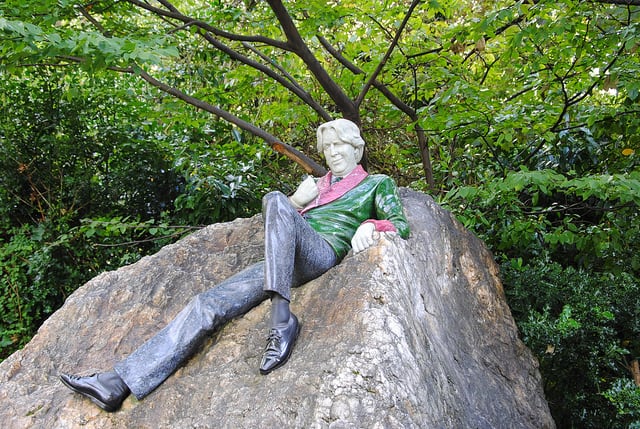Few cities have made a contribution to world literature like Dublin’s Fair City. With greats such as Swift, Burke, Moore, Wilde, Stoker, Yeats, Joyce, Shaw and Beckett, it’s no surprise that Dublin was recently designated a UNESCO City of Literature. Only four cities in the world have received this honour, so it clearly has earned its place in literary history.
Dublin Writers Museum
 creativecommons/psyberartist
creativecommons/psyberartist
Any visit to literary Dublin must start at the Dublin Writers Museum. The museum, which occupies a beautiful 18th century house in Parnell Square, promotes interest in Ireland as a whole, as well as the lives of Ireland’s famous writers.
This is a place where visitors learn about Irish writing and its influence on modern literature. Throughout Dublin there are smaller museums dedicated to writers such as Joyce, Pearse, Shaw and Yeats, but the Dublin Writers Museum pulls together Irish literature and presents it as a part of the city’s history.
Trinity College
 creativecommons.org/Craig Murphy
creativecommons.org/Craig Murphy
Follow your visit at the museum with a trip to Trinity College, where scholars such as Jonathan Swift and Oscar Wilde studied. More than a university, the Trinity College Library is the largest library in Ireland and it has the legal deposit rights for all material published in Ireland.
It is also the home of the beautiful Book of Kells – which dates from around 800 – an illuminated Latin manuscript gospel. This stunning manuscript is generally considered to be one of Ireland’s finest national treasures.
WB Yeats
 creativecommons.org/Nico Kaiser
creativecommons.org/Nico Kaiser
Stop in at the National Library to explore an interactive exhibit about the life of WB Yeats. Read his private notebooks and listen to his Nobel Prize winning poetry read by Irish celebrities and poets.
Yeats was also one of the driving forces behind creating the Abbey Theatre, a theatre for the presentation of Irish and Celtic literary works. Many Irish playwrights and actors honed their skills in the Abbey, which is located on Lower Abbey Street. Sadly, fire destroyed the original building in 1955, but it was rebuilt in 1966 and is still an active art centre in Dublin.
Grab a pint in 200-year-old Toner’s Pub, which served as Yeats’ watering hole. Well – he went there once – but he went with Oliver St John Gogarty, who lives on in history as Buck Mulligan in James Joyce’s Ulysses.
James Joyce
 creativecommons.org/rubenvike
creativecommons.org/rubenvike
Joyce preferred to spend his time in Davy Byrne’s Pub, which he also mentions in Ulysses. Although Joyce spent much of his adult life in Europe, his characters and settings are focused on Dublin. There are few physical reminders of Joyce throughout Dublin, but his pivotal works paint a picture of the city that Dubliners cherish. Head for Hodges Figgis bookshop to pick up some of his works, and ask them to show you the mention of the shop in Ulysses.
Gerard Manley Hopkins
 creativecommons.org/IrishFireside
creativecommons.org/IrishFireside
The Newman House was home to English poet Gerard Manley Hopkins during some of the worst years of his life. In a constant state of depression, Hopkins wrote his ‘terrible sonnets’ there, and later died in the same building. Joyce also featured Newman House in his semi-autobiographical Portrait of an Artist as a Young Man.
Hopkins rests in Glasnevin Cemetery along with James Joyce’s parents and Maud Gonne, the inspiration for Yeats’ Cathleen ní Houlihan.
Oscar Wilde
 creativecommons.org/Leandro’s World Tour
creativecommons.org/Leandro’s World Tour
Oscar Wilde earned his first shilling in Kennedy’s Bar, when it included a grocery store. The building is ideally placed for the literary crowd, sitting just a few steps from 1 Merrion Square, Oscar Wildes’ childhood home, and a few more steps from Trinity College. In addition to being Wilde’s preferred pub, Samuel Beckett, Seamus Heaney and Joyce also enjoyed the atmosphere of Kennedy’s.
Number 1 Merrion Square now houses a cultural facility with regular exhibitions. A statue of Wilde composed of granite, jade, jadeite and thulite adorns Merrion Square Park.
Jonathan Swift
 creativecommons.org/Jim Linwood
creativecommons.org/Jim Linwood
Jonathan Swift was born and raised in Dublin by his uncle. He attended Kilkenny College and Trinity College, where he received his BA and a Doctor of Divinity degree. He served as the Dean of St Patrick’s Cathedral from 1712 to 1745, a fact that surprises many people. He is buried there next to his long-time companion, Esther Johnson.
Samuel Beckett
Samuel Beckett grew up in the Dublin suburb of Foxrock, where his family home still exists. He attended Trinity College, moved to Paris and met James Joyce, who had a huge influence on his writing. Beckett spent several years travelling through Europe while producing his works. He is buried in Paris.
Seamus Heaney
Seamus Heaney was born in Northern Ireland, but he spent his later years in Dublin. He was truly a gift to the whole of Ireland. He is buried at his family home in Bellaghy, but his last days were spent in Dublin, and his funeral was held in Donnybrook.


